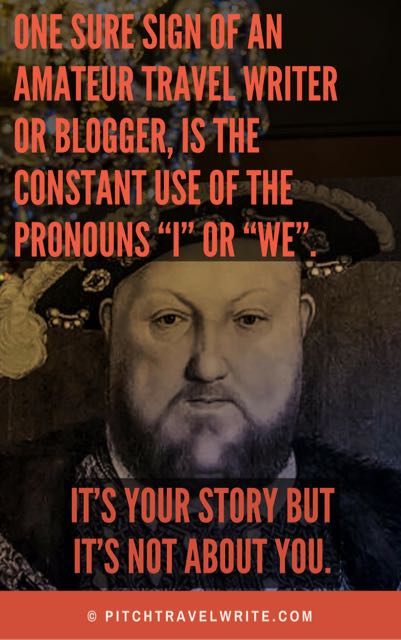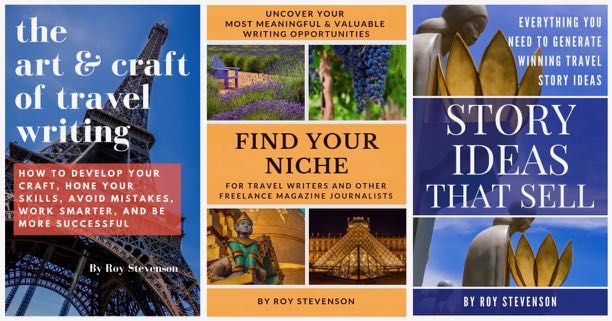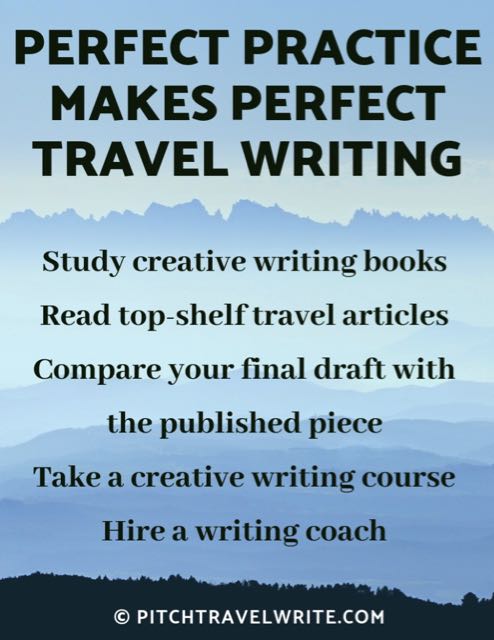- Home
- Travel Writing Craft Resources
- Best Travel Stories - Effective 1st Person Writing
The Best Travel Stories
Aren't About You
By Roy Stevenson
The best travel stories make the reader feel like they're at the destination. You, the travel writer, are the one taking them there. But how do you take them on your trip without getting in the way of the story?
One sure sign of an amateur travel writer or blogger, is the constant use of the pronouns “I” or “we” in their travel stories.
Their diary-type travel posts read something like this:
“On our first morning in Paris, we had breakfast at our boutique hotel and then we went for a stroll along the Seine. I love the romance of this city! Then we visited the Arc de Triomphe and went all the way to the top of the Eiffel Tower. After a lovely lunch at a French bistro, we toured the Louvre art museum. After dinner, we watched the show at the Folies Bergere and went back to our hotel.”
This sort of writing is fine for personal journaling. But, it’s a real
turn-off for travel magazine and online readers. It's definitely not the best travel story I've ever read. Sure, this example is
exaggerated, but I’m sad to say I’ve read way too many travel articles
and posts like this.
What’s wrong with this first-person style of travel writing?
“I went here, then there” stories are tedious. They scream ‘amateur writer’ to readers and editors.
It’s your story but it’s not about you.
Magazine
readers and editors want to know about your destination through your eyes. But, no matter how
much a place resonated with you, they aren’t interested in a
blow-by-blow narrative that reads like a diary.
First person narrative is fine -- even desired in many cases. But poorly written first person travel stories clog up the destination, rather than revealing the place.
When Writing Your Best Travel Stories Don’t Overshadow Your Destination
In travel writing the destination should be at the center of the narrative. Your readers want to feel the atmosphere of the place, see the colors, smell the smells, hear the sounds, taste the foods, and learn the history. They’re not interested in the background noise of your personal story unless it enhances the place.
Instead of dominating your articles with your personal anecdotes, use your experience as background to introduce or tell the destination’s story. The best travel stories help your readers feel and understand the place.
Even travel writing super stars like Samantha Brown, Rick Steves, Bill Bryson, Anthony Bourdain, and others of their ilk, manage to underplay themselves. They don’t overshadow their destination.
Self Discovery is good for journaling but not for your best travel stories
In addition to the monotonous “I went here, then there” travel stories, a close cousin is the invasive self-discovery travel story. This has the potential to cost you a huge numbers of readers online. And editors will reject these types of stories.
Travel writers who ramble on about their own personal voyage of self-discovery come off sounding naïve. The definitely don't fall into the realm of the best travel stories.
We all have minor (and often major) epiphanies through the wonderful medium of travel. I’ve certainly had my share. I don’t mind admitting that I’ve been brought to tears at destinations that I found, for some reason or other, particularly poignant.
Other times I’ve gazed in rapt admiration at a work of art or at natures perfect scenic glory. I’ve yearned to share these emotions with my readers.
But, apart from our immediate friends and family, few other people really care about how travel changes or affects us. People who aren’t close to us see these personal experiences as self-absorbed navel gazing.
If you don’t believe this, start telling your “personal epiphany” travel stories to acquaintances at a party. Then watch how quickly their eyes glaze over—and how fast they disappear!
Is There a Place for First Person Accounts in the Best Travel Stories?
Yes! A well-crafted first-person account of a unique journey are among the best travel stories and can be highly effective. I know a few travel writers who prefer to write their stories in the first person—and their articles sell.
Subtly injecting yourself or your feelings can greatly enhance a travel piece, if done the right way. In fact, there are plenty of travel websites (and even a few travel magazines) that prefer first-person travel stories.
Here’s one example where I got all carried away and wrote primarily about the powerful emotions I was experiencing while visiting the American Military Cemetery at Normandy.
I really took a personal gamble writing this story so emotively. I’m sure some would dismiss my piece as overdone and overly dramatic. But the website who published this piece ( YourLifeIsATrip.com ) bills itself as the “Website for Experiential Story Telling”. Given this context, such a personalized story is appropriate and expected.
Some editors want you to place yourself into the story to see how you experienced your journey. Or, they like to throw one or two personal stories into their journalistic mix.
The big key to a first person travel story is simple:
The best travel stories inject your personal feelings and emotions into your article, while still painting a clear picture of the place.
Putting yourself into the story requires finesse if it’s to be done well. Your personal perspective must be written in a subtle way, without being narcissistic or amateurish. Judging by the small number of writers who manage to pull this off with style, this is a rare talent indeed!
Here’s one of the best first person travel narratives I’ve seen in a long while. In her story, “The Meteor Shower”, in NowhereMag Annie Dawid eloquently describes her visit to the village of Sagres in Fim do Mundo on the southern tip of Portugal, to watch a meteor shower. Now this is some fine travel writing!
It’s worth noting that NowhereMag looks for narratives with “a strong sense of place, character, or time.” It’s worth spending some of your time reading some of the other stories found there.
And here’s another sample of excellent first person travel writing, about Kiev, by Yomadic Matt. Matt’s writing is rougher, edgier, and proves that it’s not necessary to use elegant prose to reveal your destination.
This is another website that you can benefit from surfing around a bit, and reading some of Matt’s other stories.

The Best Travel Stories using First Person
Your goal is to inject your observations, experiences, feelings and emotions subtly into your narrative, without “getting in the way” of your story or destination.
There’s an art to writing moving and descriptive personal travel stories. Always remember, understatement is more effective than overstatement.
Despite this, if you see the opportunity to emotionally move your readers, go for it! If you did visit a place that bit you hard or ripped your heart out (such as the Dachau Concentration Camp at Munich, and the Sachsenhausen Concentration Camp at Berlin, for example), it’s okay to bare your soul. Doing this takes great courage because we know that thousands of strangers will be reading our stories!
We’re expected to develop our own voice as our writing matures. This includes letting some of our personality and emotions leak into our stories.
But, don’t bother trying to write an emotional story about a destination that didn’t move you in some way. Your readers will sense the falseness.
My Favorite Technique for 1st person best travel stories
In case you don’t feel you can write at the level of the examples above, try my simple technique. I’ve had several first-person stories published and they’ve turned out fine.
Here’s how I write in the first person:
I introduce a place to my readers through a few brief personal observations. Then, for the best travel story I get out of the way of the story and move on.
I use my brief observations to help set the scene, and then I let the place take over. I’ll occasionally interject other observations or emotions throughout the story, to keep it rolling, or to transition to my next point. But then I step aside and move on with the place.
Below are links to four of the best travel stories where I use this technique to varying degrees. You certainly won’t need to read them all to get the idea; just read one or two.
This technique works very well. Try using it in your travel stories, and tweak it to suit your writing voice. The way you tell your story will be different from how other writers tell the same story. Don’t be afraid to experiment with your writing.
The Spectacular Edinburgh Tattoo
Luxury Hotel Barge Cruising On The Burgundy Canal
Spa Hopping and Beer Tasting in Germany's Black Forest
Wiesbaden Spas, Sightseeing and a Stunning Hotel
Break into Travel Writing
with the Creative Pack
The Creative Pack includes 3 eBooks that are the starting point for every travel writer: dreaming up unique story ideas that you can sell, finding the best writing niches for you based on your interests, passions and experience, and the art & craft of travel writing. They’re the pieces of the puzzle that come before you ever write a query letter to sell your articles to magazine editors.
If you're just getting started in travel writing, this group of resources will help you improve your craft, generate story ideas that sell, and develop your own unique and meaningful niche.
These eBooks can be purchased separately, but when you buy the bundle you'll save more than 10% off individual prices! Learn more here ...

Roy Stevenson is a professional travel writer and the author of www.PitchTravelWrite.com. Over the past ten years, he’s had more than 1000 articles published in 200 magazines, trade and specialty journals, in-flights, on-boards, blogs and websites and has traveled on assignment around the U.S. and to dozens of international destinations.
IF YOU ENJOYED THIS POST, GET UPDATES. IT'S FREE.


















